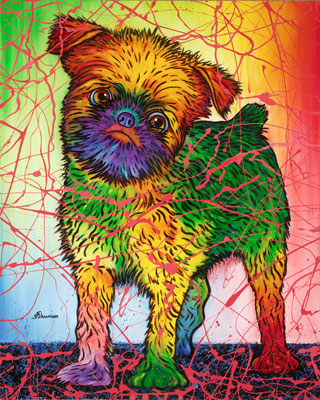
To our knowledge, there’s at least one breed from each AKC group (save the Toy and Herding group) whose coat, when properly groomed is “stripped,” or “rolled.” Both words refer to the removal of dead guard hairs once the coat is “blown” by using a stripping knife, stripping stone or one’s fingers to make room for a new coat to grow in. What results is a proper wire coat that helps a dog’s coat stand up to inclement weather.
Hand stripping a coat speeds up an otherwise natural process. When done correctly, it’s painless because wire hair isn’t attached like our own hair, or even like breeds with other types of coats. Each hair follicle supports a single hard outer hair and several soft finer hairs that form a supportive undercoat. The finer hair is very soft at the base and only lightly anchored in the follicle, and that’s why the hair pulls out easily. Hard texture and coat color are formed by the outer hairs. As these hairs grow out over time, they become thin, soft and faded at the roots. More of the softer hairs push their way out of the hair follicle. Again, hand stripping removes the old faded hairs so that new growth can happen. It helps “weed” excess fuzzy undergrowth that might be clogging the hair follicle.
While some dogs never like having their coats fussed-over, others quite enjoy having their hair stripped. The key is to “roll” or pluck a few hairs at a time, and to do it over several weeks.
It’s tempting for most pet owners to clipped and scissor their dogs because it’s quick and easy – hand stripping is a work in progress. That said, clipping hair does not render the same results as hand stripping or rolling the coat. Each time a dog’s coat is clipped instead of hand stripped, one is just taking off the top layer of dead fur rather than removing it from the roots. As a result, the coat may become duller in texture and color with each clipping. In fact, cutting the hair actually changes the structure of that hair, especially when cut below the undercoat level. Cutting off just the tip of the hair even breaks its structure. The soft base stays in the follicle and a new wire tipped hair won’t grow. The soft bottom will continue to grow awhile, and if the dog’s coat is frequently cut and not stripped, the coat stays as the soft, cottony, or downy under coat and the soft base of the wire hair from the old top coat. Sometimes, black hair even changes color.
To hand strip a dog, a small amount of hair is grasped between the thumb and forefinger and yanked in the direction that the hair grows. Some folks find that a serrated edged knife helps grip the hair (which works only if the knife is dull so it won’t cut the hair), while others use a latex glove or a finger clot (a rubber finger thimble ) to help grab the hair.
Brussels Griffon by Steve Schuman
http://stevenschuman.com/
http://stevenschuman.com/blog/

Excellent article, thank you. I use a stripping comb similar to these. I only strip the dead hair that has “let go” so as not to give the dog too much discomfort. It is not too dissimilar to combing out the dead undercoat on a double-coated breed, except this is the dead topcoat we remove, and leave the undercoat. My Norwich Terrier falls asleep while I strip her.
We LOVE hearing from the voices of experience since we, as Puli owners, allow no sharp objects near our dogs’ corded coats. Well, not strictly true. We do use scissors, but only because WE are trained professionals who adhere to the “measure twice, cut once” school of thought. Thanks for this, Sally, and thank you for posting it here where the information will forever be in our archives.